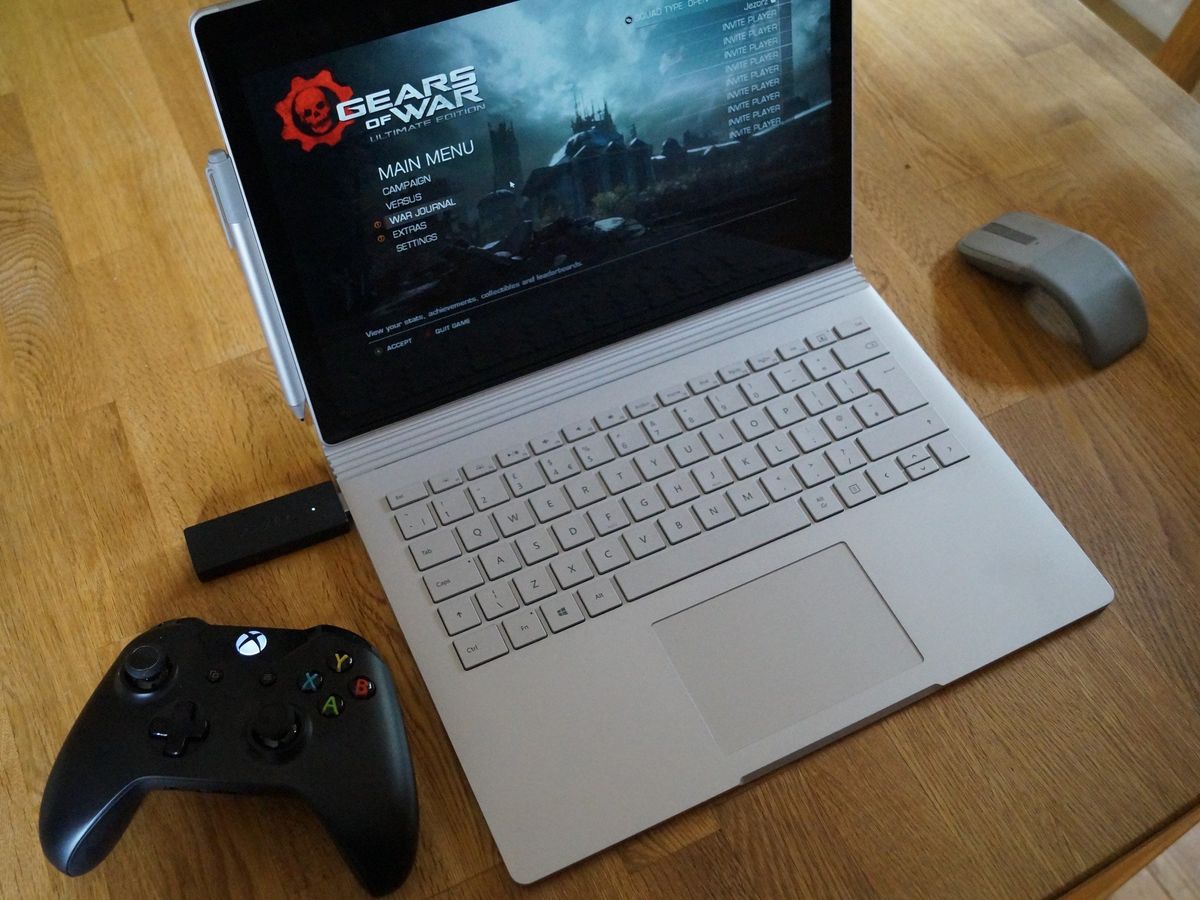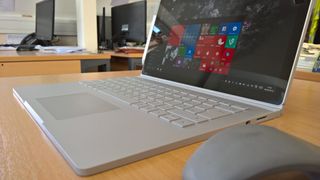Can you really game on a Surface Book? Let's find out!
While the Surface Book isn't designed or marketed as a gaming machine, Microsoft couldn't resist demonstrating its graphical chops with Gears of War at its reveal.

I do the vast majority of my gaming on Xbox One, but with Xbox Play Anywhere on the horizon, I find myself increasingly interested in laptop gaming. And at least for now, Surface Book gaming.
Of course, gaming on a laptop is sub-optimal when compared to desktop rigs designed for more effective cooling, but presumably, eventually, the technology that powers these experiences will gradually become smaller, enabling low energy consumption, high mobility gaming.

With Xbox Play Anywhere, Microsoft is already gearing up for a future where your content travels with you, regardless of what device you're using. Xbox Play Anywhere titles are buy-once, play-anywhere, providing that device runs Windows 10 and the appropriate hardware. Not only that but your content, save files, achievements and more will also roam between devices, leveraging the power of the cloud.
With more and more multiplayer games on the horizon, I began to wonder how viable the Surface Book would be to check out Xbox Play Anywhere co-operative play in upcoming titles like Gears of War 4, State of Decay 2 and Scalebound. Here's what I learned.
First, the hardware
I have a high-end Surface Book with an Intel Core i7-6600U dual-core CPU. The GPU in the Surface Book is a custom Nvidia GPU that benchmarks similarly to the GeForce 940M with 1GB of VRAM, based on the Maxwell architecture. As far as gaming is concerned, these are modest specs at best, low-end at worst. The Surface Book isn't designed to power high-end PC gaming experiences, but instead provide a highly mobile solution for creative industries working in video production or photo editing. The specs are more than suitable for Adobe Premier, Photoshop, and the like, but you should never expect to do anything other than light gaming on this thing, or at least not without substantial compromises in your game's visual settings.
The full specs on my Surface Book are as follows:
- OS: Windows 10 Pro 64-bit
- CPU: Intel Core i7-6600U dual-core @ 2.60 GHz
- RAM: 16GB dual-channel DDR3
- d-GPU: 1GB Nvidia GeForce (Custom)
- Storage: 512 GB SSD
Gears of War: Ultimate Edition
The first test is obvious. Microsoft used the third-person shooter Gears of War: Ultimate Edition to demonstrate how the Surface Book could handle modern PC games on UWP at the laptop's reveal, but how does it stack up in practice?
Get the Windows Central Newsletter
All the latest news, reviews, and guides for Windows and Xbox diehards.
Even with all the latest updates to the game and UWP, Gears of War: Ultimate Edition, as you might expect, doesn't run tremendously well on the Surface Book. But it is playable.

Initially, I ran the game on the lowest settings. Anti-aliasing disabled, texture quality on low, lowest resolution and so on. I was disappointed by the performance, which hovered at around 25-35 FPS according to the in-game frame rate counter. With the texture quality turned low as you can see above, the game looks almost obnoxiously bad, like the product of the original Xbox era.
I decided to try and boost the visuals a bit to see how much it hampered performance. I moved up to medium texture quality, turned on FXAA and found that performance wasn't really hindered in any way, but now the game looked far better. Also thankfully, the recent updates to UWP allowed games to disable V-sync, which made Gears of War: Ultimate Edition far, far more playable by reducing input lag.

Gears of War: Ultimate Edition is perfectly viable on the Surface Book with V-sync disabled with mid-range settings. It's a tad strange that I couldn't get any performance boost out of Gears by lowering the settings further. I'm reluctant to point the finger at UWP without knowing for certain, but the effects of lowering the visuals on Win32 titles seems far more pronounced.
While Gears of War was never going to look as gorgeous or run as smoothly as it does on Xbox One or a high-end PC, being able to play Gears on the go is a welcome plus to one of the most portable Windows 10 laptops on the market.
See Gears of War Ultimate Edition on the Windows Store
Killer Instinct
I simply had to test out Killer Instinct, due to the fact it was one of the first titles to be part of the Xbox Play Anywhere program. Killer Instinct is a free-to-play fighting game based on the classic Rare fighter of the 90s. It launched initially for Xbox One and eventually made its way across to the Windows 10 Store, complete with DLC purchase and progression synchronization.

Killer Instinct's settings were slightly easier to tweak because it has a performance testing mode. As a fighting game, maintaining high frame rates and razor-sharp responsiveness is pretty crucial to enable quality play, and I wasn't optimistic the Surface Book would achieve that with Killer Instinct. I was, however, quite wrong!
Killer Instinct on my Surface Book just about scraped the minimum required score for online play on low settings and resolution. On minimum settings it easily maintained a frame rate in the 50 to 60 range, and still looked fairly decent to boot.

Killer Instinct suffers immeasurably when the frame rate isn't smooth, due to the nature of its responsive combo-breaker gameplay, making the trade-off more than worth it for portable play. While the visuals and effects suffer a little, Killer Instinct is impressively optimized for play on the Surface Book's d-GPU.
See Killer Instinct on the Windows Store
Overwatch
Moving away from the Universal Windows Platform, I decided to give one of my favorite games of this generation a try: Overwatch. It might not be the most graphically intensive game out there, but it is current.
Overwatch features 6v6 battles taking place in closed, stylized arenas. Blizzard Entertainment is known for their quality PC games, and Overwatch is incredibly well optimized.
On maximum "Epic" settings, Overwatch struggled to maintain 20 FPS on my Surface Book, but it was still vaguely playable. Intensive moments with lots of players on screen force the game down to a crawl, however, making it clunky during crucial moments.

As you might expect, running Overwatch on a lower resolution than the Surface Book's 3000x2000 elicited massively positive results. Reducing texture quality and other effects help as well, but the trade-offs weren't particularly worth it. Another awesome aspect about Overwatch is that it supports the Surface Book's aspect ratio, allowing the game to fill up the screen while still on a reduced resolution.
While lowering the resolution to 1400x900 caused a performance boost by itself, running Overwatch in fullscreen exclusive mode allowed the game to run at a fairly stable 60 FPS, which is absolutely ideal for a shooter. Turning V-sync off induced some screen tearing, but it wasn't as bad as the input lag I was getting while keeping it switched on. While this is by no means the full story, Overwatch ran far better at a much higher resolution than Gears of War: Ultimate Edition and Killer Instinct, but only in fullscreen exclusive mode.
Overwatch - Medium settings, fullscreen mode, 50 to 60 frames per second.
The Surface Book is more than capable at providing a quality experience for Overwatch, albeit less pretty than its Xbox One counterpart.
3DMark
3DMark is a benchmarking tool that runs some Win32 3D scenes on your computer while monitoring how your computer's hardware meets the challenge. I ran 3D Mark's test for mid-range PCs, high-end PCs, and high-end PCs with DX12, and the results were interesting when stacked up against a Nvidia GeForce 960M and a Nvidia GTX 1080.

As you might expect, the Surface Book didn't fare too well on the high-end benchmarks, but competed adequately against the 960M on the mid-range. To say that the GTX 1080 makes a difference would be a gross, almost offensive understatement.
Sky Diver is the mid-range laptop test, Fire Strike is for high-end gaming PCs, and Time Spy is for high-end PCs running DX12. These tallies are by no means the full story (benchmarks never are), but here's a breakdown of the benchmark scores across each device.
| 3DMark Test | Surface Book | GeForce 960 M | GTX 1080 |
|---|---|---|---|
| Sky Diver | 6620 | 6867 | 37152 |
| Fire Strike | 1929 | 3442 | 16886 |
| Time Spy | 253 | 1315 | 6428 |
The tests weren't under fully controlled conditions by any means, but it at least gives us a picture of how the Surface Book stacks up against other contemporary systems. Running at 1920x1080 resolution across each device, the Surface Book managed vaguely comparable results against the GeForce 960M laptop used by Windows Central's Richard Devine. During more intensive moments, the Surface Book lost stability and frames, but overall it ran competently.
Sky Diver is probably best compared to previous-generation games like Deus Ex Human Revolution and The Witcher 2. Fire Strike, which would be more comparable to modern games like Quantum Break and Gears of War: Ultimate Edition on high settings, didn't fare so well on the Surface Book when compared to the more modern systems. Frame rates struggled between 15 and 20 FPS, but it shows that with settings tweaks, most well-optimized modern games would become playable.
Time Spy is designed for DX12 ultra high-end systems, and as you can see from the score tally, intensive games with advanced visual features are definitively a no-go for the Surface Book.
Final thoughts
To take full advantage of Xbox Play Anywhere, the Surface Book needs to be able to run games coming out of the Windows 10 Store. Games from the Windows Store are packaged under the Universal Windows Platform, which differs from the classic Win32 functionality typically found on platforms like Steam.
Lighter and older titles like Ori and the Blind Forest, Bioshock Infinite and World of Warcraft run like a treat on the Surface Book, but you'll have to compromise to get newer games running well.
UWP games have been the subject of controversy, not only from critics claiming that Microsoft is attempting to lock down the PC gaming market, but also because UWP games were previously unable to take advantage of certain higher-level GPU features, such as SLI and unlocked frame rates. Also, UWP doesn't support full-screen exclusive mode, which traditionally provides a performance boost. Microsoft says that games with DX12 don't need full-screen exclusive mode to perform correctly, and can allow users to multi-task and alt-tab more easily than games that are running with exclusive control over the screen. However, this doesn't help with games that are stuck in DX11 or under, or games that are simply poorly optimized.
Reducing the settings to minimum on UWP games like Gears of War Ultimate Edition, Quantum Break and Shadow Complex: Remastered barely impacted how well those games ran on my Surface Book. Whereas reducing the visuals on Win32 titles like DOOM, Overwatch and The Witcher 3 had a very pronounced effect. These comparisons ignore a lot of factors, of course, but at least in practice, it doesn't feel like UWP can best Win32 on the low end right now.
Less intensive titles like Ori and the Blind Forest, or older previous-gen Win32 titles like Bioshock Infinite and World of Warcraft run like a treat on the Surface Book, but you're looking at a lot of compromises to get newer games running well on this device. It's just not intended for gaming. Its features flow towards productivity and mobility, with light gaming as a consequence of its decent hardware.
For $2,699, I would have liked to have seen at least a quad core processor in this thing, maybe a GPU based on at least the 950M rather than the 940M, but the Surface Book price factors in more than its internals. Its build quality, rich display, unique 2-in-1 configuration and pressure sensitive screen all contribute to the laptop's versatility. If gaming is your central use-case for a PC, look elsewhere. But if you find the features attractive, and you're looking for a capable, highly mobile workhorse that can hold its own in gaming, especially with Win32's sizable back catalog, then the Surface Book might be ideal.

Jez Corden is the Executive Editor at Windows Central, focusing primarily on all things Xbox and gaming. Jez is known for breaking exclusive news and analysis as relates to the Microsoft ecosystem while being powered by tea. Follow on Twitter (X) and Threads, and listen to his XB2 Podcast, all about, you guessed it, Xbox!